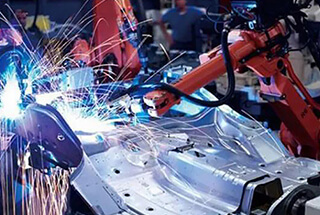Functionality of Fiber Lasers

Fiber lasers operate by using a fiber-optic cable to transmit a high-intensity laser beam. Unlike traditional lasers, which use mirrors and lenses to focus the beam, fiber lasers use a doped fiber to amplify the signal. This technology allows fiber lasers to produce a high-quality beam that can be easily adjusted to achieve specific levels of intensity and shape.
One of the key advantages of fiber laser technology is its flexibility. By using different types of fibers and adjusting the power and beam shape, fiber lasers can be used for a wide variety of applications, including cutting, marking, welding, and engraving.
Additionally, fiber lasers can operate at much higher speeds than other types of lasers, with some models able to achieve cutting speeds of up to 3,000 mm/s. This makes them ideal for use in high-speed, precision manufacturing applications.
Advantages of Fiber Lasers
One of the primary advantages of fiber lasers is their ability to produce high-quality beams with a very small spot size. This allows for extremely precise cutting, welding, and marking, even in difficult-to-reach areas. Additionally, fiber lasers are highly efficient, with some models able to convert up to 50% of the input power into laser energy.
Another key advantage of fiber lasers is their durability. Because they rely on fiber-optic technology instead of mirrors and lenses, fiber lasers are less susceptible to damage from vibration or shock. Additionally, they have no moving parts, which means that they require less maintenance than traditional laser systems.
Finally, fiber lasers offer unparalleled control over beam shape and intensity, which makes them ideal for use in a wide variety of applications. Whether you need a focused beam for precise cutting or a broader, diffuse beam for surface marking, fiber lasers can be easily customized to meet your specific requirements.
Disadvantages of Fiber Lasers
Despite their many advantages, fiber lasers do have some potential drawbacks. One of the primary disadvantages of fiber lasers is their cost. Because they require specialized optics and advanced fiber-optic technology, fiber lasers can be more expensive than other types of laser systems.
Additionally, fiber lasers can be more difficult to operate and maintain than other types of lasers. Because they rely on precise fiber-optic cables, fiber lasers may require more specialized training and expertise to operate than traditional laser systems.
Finally, while fiber lasers are highly versatile, their performance may be limited in some applications. For example, fiber lasers may not be as effective at cutting thicker materials or working with certain types of metals.
Areas of Application
Despite these potential drawbacks, fiber lasers are rapidly becoming the go-to laser system for a wide range of applications. Some of the most common uses of fiber lasers include:
- Cutting and welding: Fiber lasers are ideal for precision cutting and welding of a wide variety of materials, including metals, plastics, and composites.
- Marking and engraving: The high-quality beam produced by fiber lasers makes them ideal for surface marking and engraving applications, including product identification, branding, and part serialization.
- Automotive manufacturing: Fiber lasers are used extensively in the automotive industry for cutting and welding of exhaust systems, body panels, and other critical components.
- Medical device manufacturing: Fiber lasers are increasingly being used in the medical device manufacturing industry for cutting, welding, and marking of various components, including catheters, stents, and implants.
Conclusion
Fiber lasers are one of the most advanced and versatile laser systems in use today. Their ability to produce high-quality beams with unparalleled precision and control make them ideal for a wide range of applications, from cutting and welding to marking and engraving. While their cost and complexity may make them less suitable for some applications, their flexibility and durability make them a popular choice for manufacturers in a variety of industries.